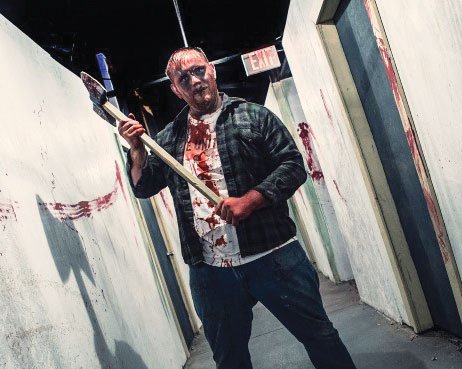
Speed Read: True Blood
The operation all started with a perfectly wholesome farm. In 1991, my parents moved to my grandparents’ massive spread in the country to help out. Three years later, a business concept and I were born at the same time, providing my mother with a way to work from home while raising me—she ran KD Stables, which entailed riding lessons, horse camps, and all things equestrian-related. Eventually, we added pony parties and petting zoos to the mix, and in 2000, we transitioned the farm into a full-blown kiddie carnival.
Things got a little weird. The next year, Mom decided she wanted to scare people, and we held our first Haunted Hayride. The year after that, though my mother’s itch had passed, word had spread, and people showed up expecting a Halloween hayride. Cue Mom’s lightbulb moment: Scaring people for a living was a jackpot idea.Today, Fear Farm accounts for around 75 percent of our family income. My dad is the only one of us left with a “real” job.
That first Halloween night has grown to 18 evenings in October. Which, when you get down to the nitty-gritty, is a mere 72 hours to make our entire living.
But no, we don’t work just one month out of the year. We hibernate between November and February, but start bouncing around new ideas in March, and building sets begins in June.
Some really cool-looking scenes just don’t stand the test of time. A Who-Ville massacre only lasted a year, though I’m positive it left some children scarred for life.
The people terrifying you are probably still taking calculus. Every night, an entirely new crowd of actors takes the stage. My family and I are joined by high school and college groups fundraising with us. For the haunt industry, training a whole new staff each night is unheard of. But we’ve got it down to a science—we can cast, costume, make up, and train 75 to 150 people assembly-line-style in about an hour and a half.
Words like “boo” and “rawr” are forbidden here. We don’t expect any of our actors to come equipped with every creepy persona in the book, but if those are your go-to words to startle people, you’re a lost cause.
We get a lot of ideas from scary movies. The celluloid creatures who scared you as a child—or maybe just last weekend at the multiplex—are a huge pool to draw from, and customers expect them. I don’t think we’ll ever be able to get rid of our “Thriller” or Beetlejuice scenes without facing a boycott.
We also swap ideas at a convention for professional scary people. We congregate at TransWorld’s Halloween & Attractions, a national event in St. Louis. From hobnobbing with creative teams from Universal Studios to buying ready-to-go scenes (something we don’t do), TransWorld is the Disneyland of the haunt industry.
There’s always a weak link in groups. Symptoms are usually easy to spot: smack-dab in the middle, cowering behind someone’s shoulders trying not to draw attention. But every now and then, there’s one that catches us completely off guard—like the buff, 6-foot-tall guy who used his girlfriend as a shield. We may or may not have replayed that several times on the security cameras.
People wetting their pants are more common than you’d think. And not just kids, either.







